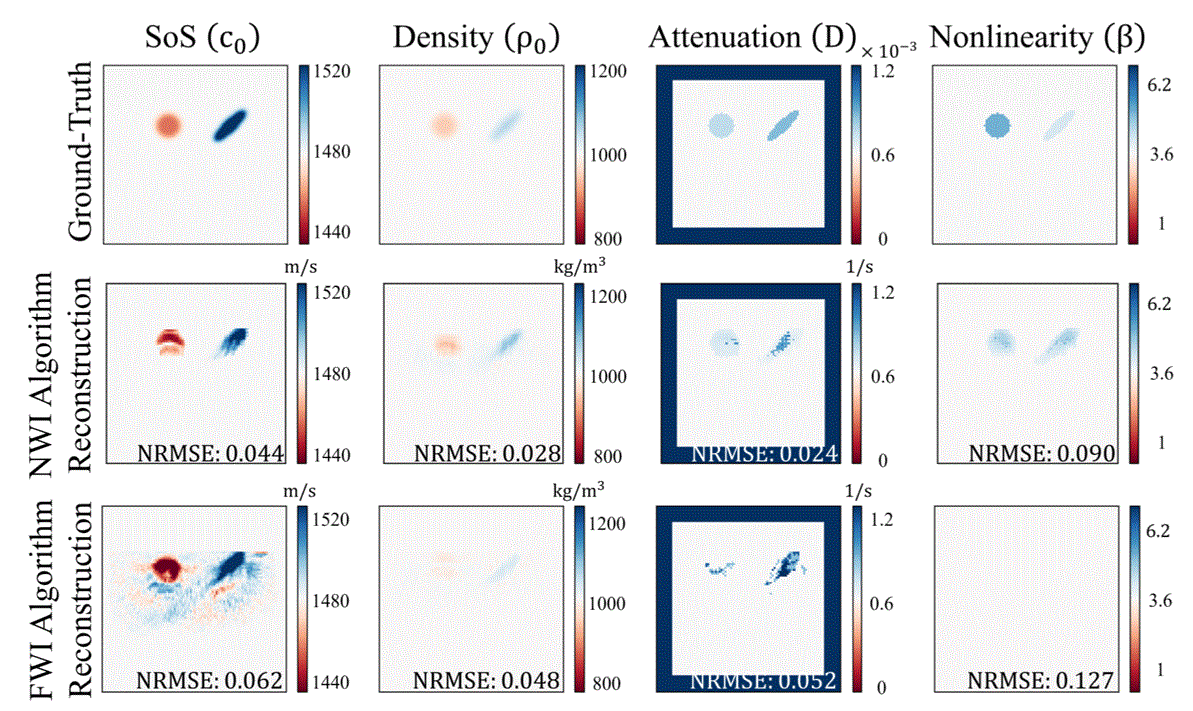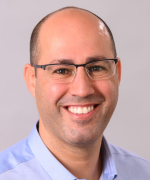Conventional ultrasound brightness-mode images do not provide sufficient contrast for certain anatomical structures and have a poor physical interpretation. This can highly affect the medical diagnosis reliability. Here we provide a novel nonlinear waveform inversion (NWI) method that solves the inverse ultrasound problem, which consists of reconstructing the physical properties of a medium based on the acquired ultrasound signal. Furthermore, by using recurrent neural networks (RNN), this method reconstructs additional physical properties compared to known methods today.
Due to its non-invasive and non-radiating nature, along with its low cost, ultrasound (US) imaging is widely used in medical applications. Typical US B-mode (Brightness-mode) images have limited resolution and contrast and weak physical interpretation. Imaging the medium's physical properties, such as speed of sound, density, and acoustic attenuation, is known to have valuable differentiation capabilities and improves medical diagnosis. Inverse US methods, such as the standard full waveform inversion (FWI) algorithm, were developed to reconstruct the media's speed-of-sound (SoS) based on a linear acoustic model. However, the wave propagation in medical US is governed by nonlinear acoustics, which introduces more complex behaviors neglected in the linear model. Neglecting nonlinear effects damages the reconstruction and can potentially affect the reliability of the medical diagnosis. Moreover, the FWI method is computationally heavy, which increases the time and cost of using inverse US techniques and precludes real-time usage.
Prof. Eldar Yonina and her team invented a novel nonlinear waveform inversion (NWI) approach for quantitative ultrasound. This is a computational technique that considers a nonlinear acoustics model to simultaneously reconstruct multiple material properties from ultrasound measurements, including the medium's SoS, density, acoustic attenuation and nonlinearity parameters.
The NWI algorithm is a model-based approach that reconstructs multiple material's properties in nonlinear media from US scans. The invented method broadens the current inverse US approaches by considering nonlinear media. The algorithm exploits the RNN representation of the nonlinear acoustics wave equation to compute the gradients efficiently, expands the range of physical properties that can be reconstructed with US and improves their reconstruction while analyzing the same acquired data used for conventional US B-mode images. Reconstructing the properties of nonlinear media is suited for medical imaging, where the tissues are highly nonlinear.
The team has demonstrated the relevance of NWI on simulative data, where it substantially reduces the reconstruction errors compared to known methods, and showed that neglecting nonlinear effects introduced artifacts to the reconstruction, damaged its quality, and doubled the reconstruction error (see Figure 1). This result emphasizes the importance of using adapted nonlinear acoustic models in medical setups.

Figure 1: Reconstruction of simulated medium properties (headers), using the NWI algorithm compared to the FWI, one of the current inverse US approaches. The left and right objects are fat and liver, respectively.
Advantages
- Non-invasive and non-ionizing process
- Additional views of the observed medium
- Improves the reconstructions of the physical properties over conventional inverse US methods
- Reduces complexity, time, and cost of applying reconstruction techniques
- Increases the reliability of medical diagnosis
- An add-on to current US modalities that enables the deployment of inverse US modalities into the clinic
- Low costs compared to other imaging modalities (X-ray imaging and MRI)
- The physical model can be adapted to other imaging modalities, such as photoacoustic and seismology
Applications
The NWI method is suited for medical applications where the imaged mediums are highly nonlinear. For example, speed of sound maps can discern between benign and malignant breast tumors, identify muscle loss and fatty muscular degeneration (sarcopenia) in seniors, and differentiate between healthy and diseased tissues such as in human and animal livers affected by nonalcoholic fatty liver disease (NAFLD). Acoustic attenuation maps can improve the diagnosis of non-healthy tissues. In addition, the tissue density can indicate a risk for breast cancer and quantify the level of fat and steatosis in the liver, which is critical to monitor NAFLD and nonalcoholic steatohepatitis (NASH). Practically, the NWI method can be implemented into medical equipment without modifying the ultrasound transducer array itself.
- Shultzman, A., & Eldar, YC (2022). Nonlinear waveform inversion for quantitative ultrasound, IEEE transactions on computational imaging, 8, 893-904, DOI:10.1109/TCI.2022.3208515


